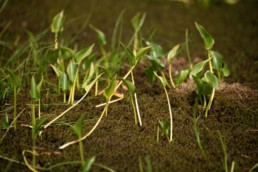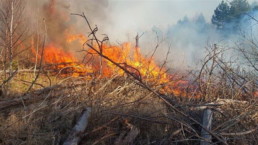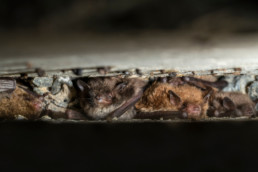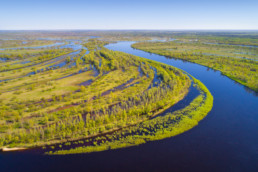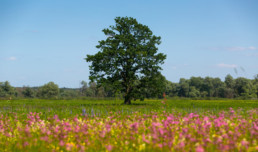For the first time in Polesia, automatic groundwater level measurement is used in wetland restoration
The practical implementation of wetland restoration in the Rivnenskyi Strict Nature Reserve began with the start of hydrological monitoring in the Syra Pohonia Bog – one of our priority restoration sites. Our project’s experts carried out the field work together with the staff of the reserve.
Polesia is extremely rich in wetland ecosystems that are crucial for maintaining biodiversity, regulating water regimes, and mitigating climate change. However, in the past century, they have been subjected to drainage reclamation and other anthropogenic impacts, which has led to significant degradation of these ecosystems. Among the negative consequences of these processes are extreme fluctuations in water levels – from lasting droughts to destructive floods, growing carbon emissions and habitat transformation, burning of woodlands and peatlands, a decrease in surface waters quantity and quality during the low water period, and the development of wind erosion. As a result, habitats are undergoing radical transformation, and peatlands are no longer able to regulate water and carbon compounds. Restoration of hydrological regimes of the disturbed wetlands is the way to prevent further ecosystem degradation and loss.
Some time ago, we jointly with our partners selected a few sites with the best prospects of restoration in the Ukrainian Polesia. Two of them are located in the Rivnenskyi Strict Nature Reserve – they are the Syra Pohonia and Somyne mire complexes.
The Rivnenskyi Strict Nature Reserve, situated in the north of Ukraine, is the largest nature reserve in the continental part of the country, covering an area of 42 291.3 hectares. The area encompasses all the types of peatlands typical for Ukrainian Polesia that makes it unique. The reserve is also an important centre for the conservation of forest ecosystems dominated by pine forests. These forests and wetlands provide a habitat for numerous rare species of flora and fauna, underscoring the reserve’s pivotal role in safeguarding biodiversity in Ukrainian Polesia.
The Syra Pohonia Bog is adjacent to the Almany Mires Nature Reserve situated to the north, across the Ukrainian-Belarusian border. Together, these sites make up the largest complex of raised, transitional mires and fens in Europe. Syra Pohonia possesses the features of a northern wetland (taiga) that is unique to Ukraine and Central Europe. It is home to a variety of flora and fauna, including wetland bird species, such as the Greater Spotted Eagle which is at risk of extinction. Syra Pohonia has been badly affected by drainage and wildfires.

Works on restoration of the hydrological regime of the Syra Pohonia Bog involve specialists of our project, employees of the Rivne Strict Nature Reserve and the National University of Water and Environmental Engineering (in Rivne, Ukraine). The recently launched hydrological monitoring will track the ground water levels in the reserve’s disturbed mires and the outflow of water from the canals.
Automated methods of water regime control have been introduced to assess the effectiveness of the restoration work. The specialists are now able to process not only the data from the existing network of groundwater level observations within the reserve, but also the data periodically collected by means of modern equipment, such as an electromagnetic flow meter, automatic groundwater level and temperature data loggers (divers). With information about changes in water levels, the project team will be able to make informed decisions in the future to ensure that the restoration is carried out correctly and safely. The monitoring scheme is designed to assess the impact of the drainage channels and evaluate the effectiveness of the restoration measures.
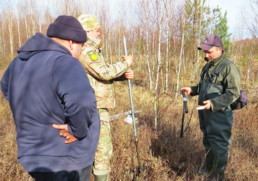
According to experts’ estimates, now, Syra Pohonia loses about 2.5 million cubic meters of water per month during the spring flood due to the impact of drainage channels. Instead of accumulating water in the wet season and releasing it in the dry season, this water flows rapidly in the spring, causing flooding in the surrounding villages downstream. Instead, during the dry summer and fall months, there is a significant shortage of water and soil moisture, which leads to the spread of fires and has a negative impact on agriculture in the areas adjacent to the mires.

Serhiy Sorokin, regional project coordinator at the Frankfurt Zoological Society:
“We recognize the importance of restoring this bog not only for the environment, but also for the people who live near the reserve. By restoring the mires and carefully monitoring the hydrological conditions, we aim to improve the ecological balance, prevent excessive flooding, and create a more sustainable landscape for future generations”.
Fluctuations in the groundwater levels have a particularly strong impact on the local population, especially on residents of adjacent villages, who often suffer from seasonal flooding. By restoring marshland areas in the Syra Pohonia and Somyne massifs, the project initiators aim to raise and stabilize the water table within the reserve to reduce extreme water fluctuations outside of it, thereby reducing the risk of future flooding. This monitoring program will not only support the restoration process, but will also serve to inform communities of potential changes in water levels that could have a positive impact on their lives, such as increased water levels in wells or reduced risk of flooding of private households, agricultural land and local infrastructure.
The initiative aims to restore the hydrological regime of the Syra Pohonia and Somyne peatland complexes, as well as to predict the impact of restoration measures on the ecosystem. The restoration project is expected to last for 18 months, followed by continuous monitoring and research for at least the next 10 years.
Safe and intact: protecting rare and typical habitats in Polesia
19. September 2025
0 Comments7 Minutes
The project “Polesia – Wilderness Without Borders” is part of the Endangered Landscapes & Seascapes Programme and is funded by Arcadia. The project is coordinated by Frankfurt Zoological Society (FZS).


